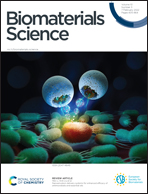Labelling stem cells with a nanoprobe for evaluating the homing behaviour in facial nerve injury repair
Abstract
It is crucial and clinically relevant to clarify the homing efficiency and retention of stem cells in different implanting strategies of cell therapy for various injuries. However, the need for a tool for investigating the mechanisms is still unmet. We herein introduce multi-modal BaGdF5:Yb,Tm nanoparticles as a nanoprobe to label adipose-derived stem cells (ADSCs) and detect the homing behavior with a micro-computed tomography (micro-CT) imaging technique. The migration of cells injected locally or intravenously, with or without a chemokine, CXCL 12, was compared. A higher homing efficiency of ADSCs was observed in both intravenously injected groups, in contrast to the low efficiency of cell retention in local implantation. Meanwhile, CXCL 12 promoted the homing of ADSCs, especially in the intravenous route. Nonetheless, the administration of CXCL 12 showed its therapeutic efficacy, whereas intravenous injection of ADSCs almost did not. Our work provided a tool for in vivo imaging of the behavior of implanted cells in preclinical studies of cell therapy, and more importantly, implied that the parameters for implanting stem cells in clinical operation should be carefully considered.



 Please wait while we load your content...
Please wait while we load your content...